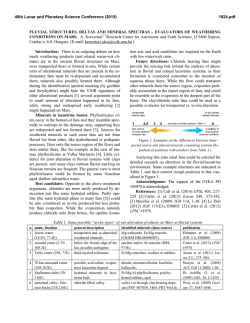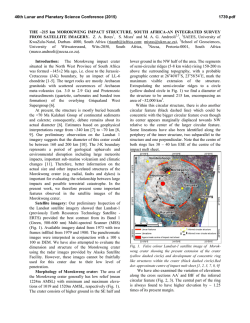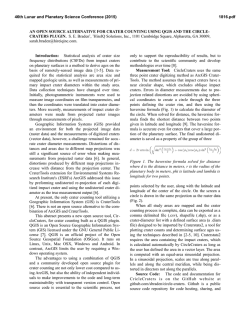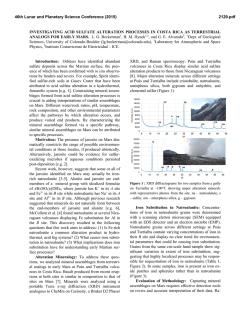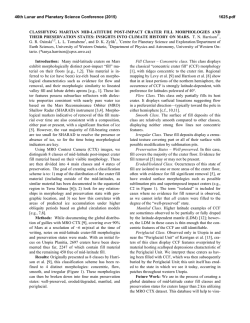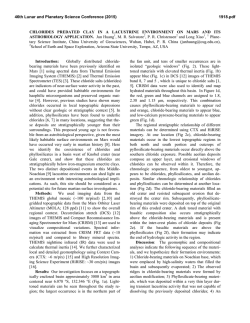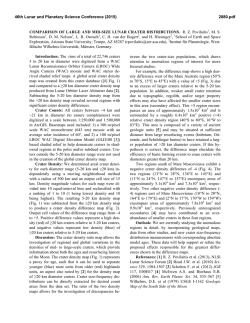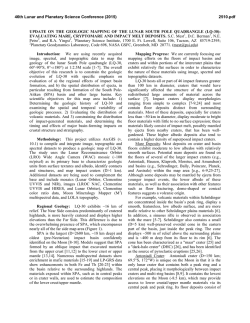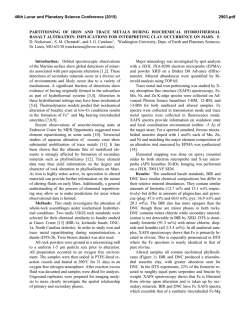
Spectral Identification of Acid Sulfate Alteration Products in Costa
46th Lunar and Planetary Science Conference (2015) 2260.pdf SPECTRAL IDENTIFICATION OF ACID SULFATE ALTERATION PRODUCTS IN COSTA RICA VOLCANOES: IMPLICATIONS FOR EARLY MARS. S. R. Black1,2, B. M. Hynek1,2, and G. E. Alvarado3, 1 Laboratory for Atmospheric and Space Physics & 2 Dept. of Geological Sciences, University of Colorado-Boulder, Campus Box 600 UCB, Boulder, CO 80303, 3 Instituto Costarricense de Electricidad – ICE, [email protected] Introduction: CRISM and OMEGA data have identified many locations on Mars with mineral assemblages consisting of phyllosilicates, sulfates, and hydrated silica [e.g. 1, 2]. Several formation models have been proposed for these materials [3-6] In some instances, it appears that one location may have undergone multiple processes [7-10]. In other instances, it appears that multiple processes could each have produced the observed deposits [11-13]. Some areas on Mars show putative hydrothermal characteristics, such as Home Plate and nearby soils in Gusev Crater [7-10], hydrated silica deposits around the summit area of a cone within the Nili Patera caldera [11], and lighttoned deposits within Noctis Labyrinthus [12, 13]. Motivation: Many studies [14-16] have been completed to assess acid sulfate hydrothermal alteration of terrestrial basalts, with the aim of interpreting ancient Martian environments and their potential for habitability. Given our current understanding of hydrothermal alteration products, it is not possible to constrain many of the specific details about the alteration environment. To better understand paleoenvironments on Mars, terrestrial analogs are needed. Several studies have been done using terrestrial analogs in Nicaragua [14-16], which have identified trends between parent lithology, pH, temperature, and fluid/rock ratio with the mineralogy of alteration products. The aim of this work is to expand our understanding of environmental controls on alteration mineralogies by using hyperspectral field data acquired on Costa Rican volcanoes and analysis of satellite data. The Costa Rican volcanoes have differing lithologies and gas/fluid compositions than previous analogs, allowing for further refinement of the controls of acid-sulfate alteration. Methodology: Data were gathered on Poás, Turrialba, and Miravalles volcanoes using a field-portable visible near infrared spectrometer. Sampling focused on areas with active fumaroles or hot springs, areas of prior fumarolic activity, and areas in the current acid fog clouds. In-situ sampling of all visible mineralogical (color) variations was done in each location. 53 spectra were gathered within the Turrialba summit crater, and 77 within the Poás summit crater. The Hornillos/Hornitos hot spring site on Miravalles yielded 10 spectra. Field spectra were analyzed using ENVI software and USGS and CAT tools libraries [17]. Results: Miravalles: Miravalles is of interest due to its location in the Guanacaste Region of northwest- ern Costa Rica. Volcanoes in this area lie in the transition zone, with MORB-type magmas to the north and OIB-type magmas to the south [18]. Samples collected around the the hot spring indicated several occurrences of hematite, hexahydrite, and hydrated silica. Goethite, jarosite, natrojarosite, pickingerite, and elemental sulfur were also identified. Poás: Poás’ extremely acidic, high temperature active fumaroles and acid-chloride crater lake are a dynamic geochemical system, and an excellent location to study alteration products in OIB-hosted lavas. Several locations were sampled within the Poás summit crater. Spectra were interpreted to be predominantly hydrated silica, hematite, Fe-rich natroalunite, and alunite. There were also spectra indicating the presence of hexahydrite, halloysite, jarosite/natrojarosite, kaolinite/smectite mixture, goethite, pickingerite, gypsum, and elemental sulfur [Fig. 1]. Figure 1: Top – Sampling locations within the Poás summit crater; A – flat area east of crater lake, B – east side of cone, C – south side of cone, D – active fumarole, E – southeast crater wall, and F – a gully on the south crater wall. Bottom – Examples of spectra collected within the Poás summit crater. Turrialba: Turrialba and Poás both have active fumaroles and crater lakes, but differing chemistries, 46th Lunar and Planetary Science Conference (2015) temperatures, and pH [19, 20]. Spectra were interpreted as hydrated silica, hematite, alunite, jarosite, Fe-rich natroalunite, gypsum, and montmorillonite. Satellite data: Satellite data for the Turrialba summit crater exist from both HyMap and MASTER. Currently, only MASTER coverage exists for Poás’ summit crater, and no satellite coverage exists for Miravalles. HyMap’s 15 m/px and 6 nm/band resolution – similar to CRISM’s 18.4 m/px and 6.55 nm/band – make it possible to roughly locate areas with easily distinguishable absorption features such as kaolinite and montmorillonite, which appear to be abundant along the west wall of the Turrialba summit crater in an area exposed to acid fog [Fig. 2]. Identification of other common sulfates, such as gypsum, is inconclusive due to corrupted bands in the 1.6-1.7 µm wavelengths of the HyMap data. MASTER’s 9 m/px resolution but much coarser 80 nm/band resolution does not allow for identification of materials within either summit crater. Detailed identification is unlikely for all sites, due to the low field area/pixel size ratio. Figure 2: HyMap data superimposed over a true color image of the Turrilaba summit crater, showing identification of kaolinite (red), montmorillonite (green), and hydrated silica (dark bue). Discussion: A common feature for all three sites was the abundance of Al-phyllosilicates and Alsulfates. The abundance and diversity of Al-bearing alteration products correlates with the level of Alenrichment in the parent rock. Additionally, variations in the presence of gypsum also appear to correlate with parent lithology. Gypsum was identified at both Poás and Turrialba. However, no gypsum was identified at Miravalles, which is depleted in CaO relative to Poás and Turrialba [19-21]. These trends are in agreement with previous work [14]. Although Fe,Mg-smectites, such as nontronite, are often present in acid-sulfate alteration products, the lack of abundant nontronite in the spectral data (identified only at one location within the Poás summit crater) may be attributed to the prolonged exposure to an acidic environment and low pH fluids [5]. The diversity of alteration products varies between the sites as well, and appears to correlate with cation 2260.pdf abundances in the circulating fluid, as well as the variety in modes of alteration (e.g.; precipitation, fumaroles, acid-fog). Miravalles, a small hot spring, shows the lowest amount of diversity, while the greatest diversity appears at Poás. Poás’ hot, acidic crater lake and fumaroles are an excellent means to leach cations, and the subsequent fluids allow for the formation of a wide variety of alteration products [14]. Additionally, Poás’ summit crater is undergoing alteration through several mechanisms (precipitation from circulating groundwater, active fumaroles, and acid-fog alteration). Each of these mechanisms may produce distinctive variations in mineralogy due to its unique processes. Our results indicate that areas on Mars containing diverse mineralogies, such as Noctis Labyrinthus [12, 13] and Home Plate [7-10], may have underwent alteration via multiple processes. It is also possible that these areas had fluid enriched in a variety of cations, and/or a parent lithology enriched in a wide assortment of elements. The apparent absence of sulfates at Nili Patera [11] may not be an due to an actual absence of sulfates. Our analog study shows that the small field areas used in this study relative to pixel size would not allow detailed identification of deposits with CRISM data. Instead, a precise mineralogical assessment requires ground-based observations. Comparisons of in-situ and orbital data show far more mineralogical variety on the ground than is evidenced from orbit. Without ground-based sampling, it is possible to speculate on the geologic history of a region; however, small-scale variations, which provide further insight, are not represented. Correspondingly, many hydrothermal systems on Mars may miss detection with instruments akin to CRISM or OMEGA. References: [1] Murchie et al. (2009) JGR, 114.; [2] Carter et al. (2013) JGR: Planets, 118.; [3] Bibring et al. (2006) Science, 312(5772).; [4] Baldridge et al. (2009) GRL, 36.; [5] Altheide et al. (2010) Geochim. Cosmochim. Acta, 74(21).; [6] Andrews-Hanna et al. (2010) JGR 115.; [7] Morris et al. (2008) JGR, 113.; [8] Squyres et al. (2008) Science, 320.; [9] Schmidt et al. (2009) EPSL 281.; [10] Ruff et al. (2011) JGR, 116.; [11] Skok et al. (2010) Nat. Geosci. 3(12); [12] Thollot et al. (2011) EPSC-DPS Abstracts, 6.; [13] Weitz et al. (2011) Geology, 39(10).; [14] Hynek et al. (2013) JGR: Planets, 118.; [15] Marcucci et al. (2013) JGR: Planets, 118.; [16] McCollom et al. (2013) JGR: Planets, 118.; [17] Clark et al. (2007) Digital Data Series, U.S.G.S.; [18] Herrstrom et al. (2014) Geology, 23(7); [19] Prosser and Carr (1987) JVGR, 33.; [20] Reagan and Gill (1989) JGR 94(B4).; [21] EarthChem petrology database (2014), Smithsonian Inst. Glo. Volc. Prog.
© Copyright 2025
